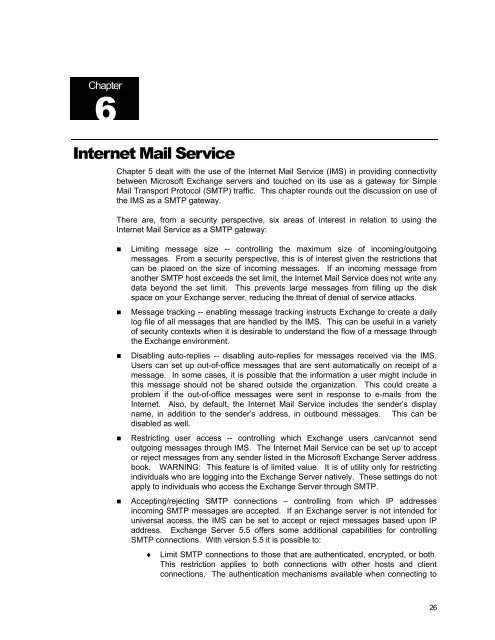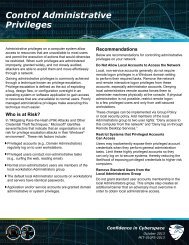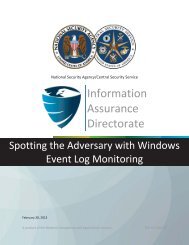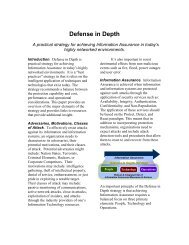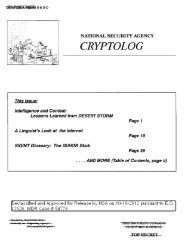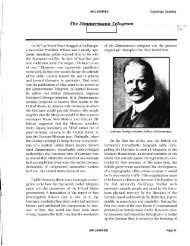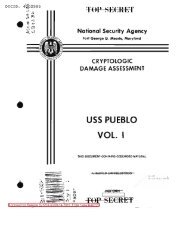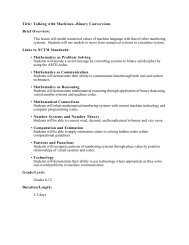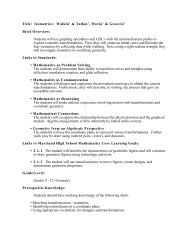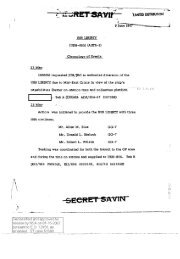Guide to the Secure Configuration and Administration of Microsoft ...
Guide to the Secure Configuration and Administration of Microsoft ...
Guide to the Secure Configuration and Administration of Microsoft ...
You also want an ePaper? Increase the reach of your titles
YUMPU automatically turns print PDFs into web optimized ePapers that Google loves.
Chapter<br />
6<br />
Internet Mail Service<br />
Chapter 5 dealt with <strong>the</strong> use <strong>of</strong> <strong>the</strong> Internet Mail Service (IMS) in providing connectivity<br />
between Micros<strong>of</strong>t Exchange servers <strong>and</strong> <strong>to</strong>uched on its use as a gateway for Simple<br />
Mail Transport Pro<strong>to</strong>col (SMTP) traffic. This chapter rounds out <strong>the</strong> discussion on use <strong>of</strong><br />
<strong>the</strong> IMS as a SMTP gateway.<br />
There are, from a security perspective, six areas <strong>of</strong> interest in relation <strong>to</strong> using <strong>the</strong><br />
Internet Mail Service as a SMTP gateway:<br />
Limiting message size -- controlling <strong>the</strong> maximum size <strong>of</strong> incoming/outgoing<br />
messages. From a security perspective, this is <strong>of</strong> interest given <strong>the</strong> restrictions that<br />
can be placed on <strong>the</strong> size <strong>of</strong> incoming messages. If an incoming message from<br />
ano<strong>the</strong>r SMTP host exceeds <strong>the</strong> set limit, <strong>the</strong> Internet Mail Service does not write any<br />
data beyond <strong>the</strong> set limit. This prevents large messages from filling up <strong>the</strong> disk<br />
space on your Exchange server, reducing <strong>the</strong> threat <strong>of</strong> denial <strong>of</strong> service attacks.<br />
Message tracking -- enabling message tracking instructs Exchange <strong>to</strong> create a daily<br />
log file <strong>of</strong> all messages that are h<strong>and</strong>led by <strong>the</strong> IMS. This can be useful in a variety<br />
<strong>of</strong> security contexts when it is desirable <strong>to</strong> underst<strong>and</strong> <strong>the</strong> flow <strong>of</strong> a message through<br />
<strong>the</strong> Exchange environment.<br />
Disabling au<strong>to</strong>-replies -- disabling au<strong>to</strong>-replies for messages received via <strong>the</strong> IMS.<br />
Users can set up out-<strong>of</strong>-<strong>of</strong>fice messages that are sent au<strong>to</strong>matically on receipt <strong>of</strong> a<br />
message. In some cases, it is possible that <strong>the</strong> information a user might include in<br />
this message should not be shared outside <strong>the</strong> organization. This could create a<br />
problem if <strong>the</strong> out-<strong>of</strong>-<strong>of</strong>fice messages were sent in response <strong>to</strong> e-mails from <strong>the</strong><br />
Internet. Also, by default, <strong>the</strong> Internet Mail Service includes <strong>the</strong> sender’s display<br />
name, in addition <strong>to</strong> <strong>the</strong> sender’s address, in outbound messages. This can be<br />
disabled as well.<br />
Restricting user access -- controlling which Exchange users can/cannot send<br />
outgoing messages through IMS. The Internet Mail Service can be set up <strong>to</strong> accept<br />
or reject messages from any sender listed in <strong>the</strong> Micros<strong>of</strong>t Exchange Server address<br />
book. WARNING: This feature is <strong>of</strong> limited value. It is <strong>of</strong> utility only for restricting<br />
individuals who are logging in<strong>to</strong> <strong>the</strong> Exchange Server natively. These settings do not<br />
apply <strong>to</strong> individuals who access <strong>the</strong> Exchange Server through SMTP.<br />
Accepting/rejecting SMTP connections – controlling from which IP addresses<br />
incoming SMTP messages are accepted. If an Exchange server is not intended for<br />
universal access, <strong>the</strong> IMS can be set <strong>to</strong> accept or reject messages based upon IP<br />
address. Exchange Server 5.5 <strong>of</strong>fers some additional capabilities for controlling<br />
SMTP connections. With version 5.5 it is possible <strong>to</strong>:<br />
♦ Limit SMTP connections <strong>to</strong> those that are au<strong>the</strong>nticated, encrypted, or both.<br />
This restriction applies <strong>to</strong> both connections with o<strong>the</strong>r hosts <strong>and</strong> client<br />
connections. The au<strong>the</strong>ntication mechanisms available when connecting <strong>to</strong><br />
26


